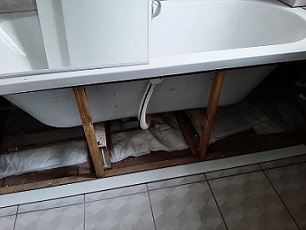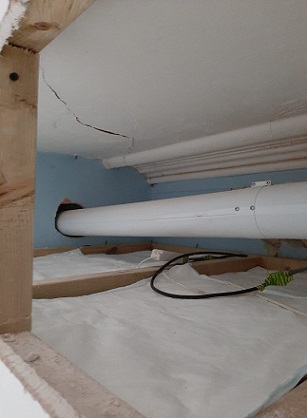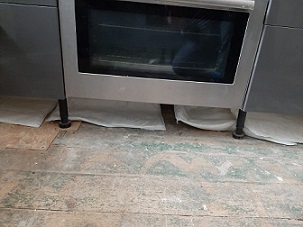 FloodSax beneath the bath in Christine Butler's flat
FloodSax beneath the bath in Christine Butler's flat
 FloodSax beneath the central heating boiler outlet pipe in Christine Butler's flat
FloodSax beneath the central heating boiler outlet pipe in Christine Butler's flat
 FloodSax beneath the kitchen units and oven in Christine Butler's flat
FloodSax beneath the kitchen units and oven in Christine Butler's flat
When Christine Butler suffered damage to her ceiling from a leak in an upstairs flat she decided she’d do all she could to prevent if from happening in her home.
She lives in a flat in a listed building in Great Malvern, Worcestershire, but was worried that if anything leaked in her flat the water would seep into neighbours’ homes.
She searched for a solution and had a ‘lightbulb’ moment when she spotted FloodSax alternative sandbags and realised they would absorb any water leakage.
FloodSax resemble large pillowcases until they come into contact with water. The semi-porous inner liner within FloodSax contains a special gelling polymer with hundreds of absorbent crystals which absorbs up to 20 kilos of water. This causes them to expand until they resemble a traditional sandbag but they can also be used in homes and businesses to soak up leaks, especially in hard-to-reach places.
Christine has now put FloodSax beneath anywhere in her three-bedroomed flat which could potentially leak so they are protecting the boiler, sinks and beneath all the kitchen cabinets and appliances.
She said: “It’s amazing how often leaks happen in people’s homes and this is one way to decrease that anxiety. We’ve had a leak before into our flat from one upstairs which left a large brown stain on the ceiling.
“This is why I’m so keen to prevent any water leaking from our flat so I’ve popped a FloodSax under any place in the flat where there could be a potential leak in the future. Once you have a leak which causes damage it’s such a hassle sorting out all the insurance which is why it’s best to prevent it in the first place.
“It also means that if water leaked into my flat from neighbouring flats the FloodSax would soak it up and minimise the damage.”
FloodSax are very thin in their dry state so are ideal to put anywhere water could leak and their special gelling polymer soaks up water. If enough water goes in, the FloodSax will eventually expand to resemble a traditional sandbag but if it’s a slight leak the tell-tale signs of a watermark or the FloodSax slightly rising will be enough of an early warning that a repair is needed. This could potentially save countless thousands of pounds in damage if the leak was to worsen and become a flood.
Christine added: “The FloodSax is like an early warning system which gives people valuable time to sort a plumber out before it deteriorates and that’s why I have them under anywhere which could cause a flooding problem.”
FloodSax managing director Richard Bailey said: “The clever way Christine is using FloodSax is exactly how they should be used indoors for flood prevention. If there is a slight leak the mark will show up on the white material, giving people time to sort the problem out before it develops into a flooding disaster.”
FloodSax is now being actively promoted among facilities managers throughout the UK.
FloodSax are widely used by local councils, flood action groups, homeowners and businesses as effective flood barriers to stop floodwater getting into homes and commercial properties.
Some councils recommend FloodSax (www.floodsax.co.uk) alternative sandbags for flood protection which are a flexible alternative to traditional sandbags and are space-saving to store and quick and easy to deploy.
More than 2.5 million have now been sold worldwide.
To buy FloodSax go to www.floodsax.co.uk/buy/uk-suppliers